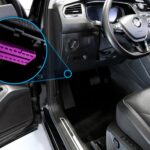P1443 and P1151 are common OBD2 codes on a 1997 Ford Thunderbird. Understanding these codes and their potential causes can help you diagnose and fix the issue. This article outlines the meaning of each code and provides a comprehensive troubleshooting guide.
Understanding Ford OBD2 Code P1443
Code P1443 signifies a problem with the Evaporative Emission Control (EVAP) system. Specifically, it indicates an incorrect purge flow from the EVAP canister purge valve. This valve controls the flow of fuel vapors from the charcoal canister to the engine for combustion. A faulty flow suggests a problem within this system.
Possible causes for P1443 include:
- Obstructed, open, or cracked hoses: Hoses connecting the EVAP canister purge valve and the intake manifold can become damaged, leading to incorrect purge flow.
- Damaged EVAP canister purge valve: A malfunctioning purge valve itself can prevent proper flow control.
- Damaged PF sensor: A faulty purge flow sensor can provide inaccurate readings, triggering the P1443 code.
Understanding Ford OBD2 Code P1151
Code P1151 indicates a problem with the upstream (front) oxygen sensor (O2 sensor) on Bank 2 of the engine. The code suggests that the sensor is not switching properly, detecting a lean condition (too much air, not enough fuel) in Bank 2. This lean condition can lead to poor performance and increased emissions.
P1151, along with related codes like P1131 (Bank 1 lean), P1132 (Bank 1 rich), P1152 (Bank 2 rich), and P1130/P1150 (maximum fuel compensation reached), point to potential issues in the fuel or air delivery systems.
Potential Causes of P1151 and Related Codes
Several issues can trigger these codes, including problems with:
- Fuel System: Excessive or low fuel pressure, leaking fuel injectors or pressure regulator, and contaminated injectors can disrupt the fuel/air ratio.
- Induction System: Air leaks after the Mass Air Flow (MAF) sensor, vacuum leaks, restricted air intake, issues with the Positive Crankcase Ventilation (PCV) system, fuel purge system problems, or even an improperly seated dipstick can introduce extra air into the engine, causing a lean condition.
- Exhaust Gas Recirculation (EGR) System: A leaking EGR gasket, stuck open EGR valve, or leaking diaphragm can introduce exhaust gases into the intake, affecting the fuel/air mixture.
- Base Engine: Issues like oil overfill, incorrect cam timing, low cylinder compression, and exhaust leaks before the O2 sensors can also contribute to these codes.
Troubleshooting P1443 and P1151
When diagnosing these codes, start with a thorough inspection of:
- Air Intake System: Check for leaks, obstructions, and damage in the air intake, air filter, and air filter housing.
- PCV System: Ensure the PCV system is functioning correctly and is free of leaks or blockages.
- Vacuum System: Check for any vacuum leaks using a vacuum gauge or by spraying carb cleaner around potential leak points.
Addressing these potential problems can resolve both P1443 and P1151, restoring your 1997 Ford Thunderbird’s performance and efficiency. Remember to consult a repair manual for specific procedures and safety precautions. Using a professional-grade OBD2 scanner can provide more detailed information to help pinpoint the exact cause of the issue.

